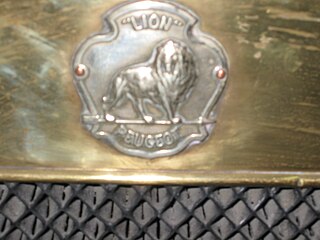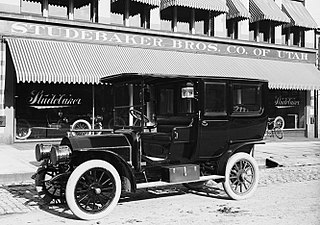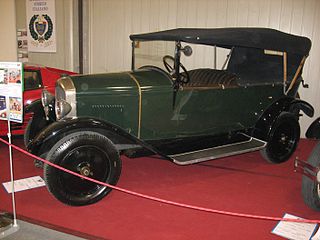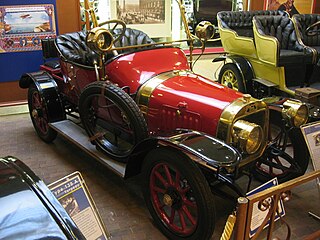The Lion-Peugeot Type VD was a motor car produced near Valentigney by the French auto-maker Lion-Peugeot in 1913. It was developed from the slightly smaller Lion-Peugeot Type V4C3 of the previous year. Approximately 800 Lion-Peugeot Type VDs were produced.

Valentigney is a commune in the Doubs department in the Bourgogne-Franche-Comté region in eastern France.

France, officially the French Republic, is a country whose territory consists of metropolitan France in Western Europe and several overseas regions and territories. The metropolitan area of France extends from the Mediterranean Sea to the English Channel and the North Sea, and from the Rhine to the Atlantic Ocean. It is bordered by Belgium, Luxembourg and Germany to the northeast, Switzerland and Italy to the east, and Andorra and Spain to the south. The overseas territories include French Guiana in South America and several islands in the Atlantic, Pacific and Indian oceans. The country's 18 integral regions span a combined area of 643,801 square kilometres (248,573 sq mi) and a total population of 67.3 million. France, a sovereign state, is a unitary semi-presidential republic with its capital in Paris, the country's largest city and main cultural and commercial centre. Other major urban areas include Lyon, Marseille, Toulouse, Bordeaux, Lille and Nice.

Lion-Peugeot is a formerly independent French auto-maker. It is the name under which in 1906 Robert Peugeot and his two brothers, independently of the established Peugeot car business, began to produce automobiles at Beaulieu near Valentigney.
For 1914 the Lion-Peugeot Type VD was replaced by the Lion-Peugeot Type V4D. The two cars differed very little from one another. Approximately 700 Lion-Peugeot Type V4Ds were produced
The Types VD and V4D were propelled using a four-cylinder 1,888 cm³ four-stroke engine, mounted ahead of the driver. A maximum 10 hp of power was delivered to the rear wheels.
The cars also became known as Lion-Peugeot 10 hp models. This was a reference to their fiscal horse power, applying a system of car classification for taxation purposes recently established in France. Tax horsepower then, and for several decades to come, was defined purely as a function of the combined surface area of the engine’s cylinders, this being far easier to assess consistently and accurately than the actual power produced by an engine. In 1913 fiscal horse-power still tended to equate approximately to actual horse-power, although the two would diverge subsequently, as engines became more efficient at extracting power from a given sum of cylinder diameters. Eventually, in the second half of the twentieth century, more complex (and less internationally consistent) definitions of fiscal horse power would replace those defined only by cylinder diameters.
The tax horsepower or taxable horsepower was an early system by which taxation rates for automobiles were reckoned in some European countries, such as Britain, Belgium, Germany, France, and Italy; some US states like Illinois charged license plate purchase and renewal fees for passenger automobiles based on taxable horsepower. The tax horsepower rating was computed not from actual engine power but by a simple mathematical formula based on cylinder dimensions. At the beginning of the twentieth century, tax power was reasonably close to real power; as the internal combustion engine developed, real power became larger than nominal taxable power by a factor of ten or more.
The Types VD and V4D featured a 2,500 mm wheel base. The 3,500 mm (approximately) overall length provided space for between two and five people depending on the body specified. The wide range of different body types offered followed a pattern that by now would have been familiar to many Lion-Peugeot buyers. It included a Torpedo, a Limousine, a “central steering” model and a small delivery van.

The torpedo body style was a type of automobile body used from 1908 until the mid-1930s which had a streamlined profile and a folding or detachable soft top. The design consists of a hood/bonnet line raised to be level with the car's waistline, resulting in a straight beltline from front to back.

A limousine is a luxury vehicle driven by a chauffeur with a partition between the driver's compartment and the passenger's compartment.
Lion-Peugeot and Peugeot: the difference
“Lion-Peugeot” is the name under which in 1906 Robert Peugeot and his two brothers, independently of their cousin Armand’s [1] "Automobiles Peugeot" company, established a car manufacturing business at Beaulieu near Vallentigny. Ten years earlier the automobile pioneer Armand Peugeot had split away from the family business after a long-standing disagreement over how intensively the company should diversify into larger scale automobile production. An agreement had at that time been entered into between Armand’s “Automobiles Peugeot” company and the residual Peugeot business that the residual business should concentrate on its established metal tools and components businesses along with its successful bicycle manufacturing activities, while Armand would have Peugeot branded powered vehicles to himself. During the ensuing ten years Armand’s automobile business had grown rapidly, although it appears that the residual Peugeot business had probably not entirely avoided producing powered vehicles. In any event, under a new agreement signed in 1905, the residual Peugeot business made Armand an annual payment in return for which Armand consented to the residual business itself producing motor cars under the “Lion-Peugeot” name. The arrangement continued until 1910 after which (the death of Robert Peugeot’s father Eugène having apparently removed a major impediment to the idea) the Lion-Peugeot business and the Peugeot automobiles business were merged into a single company. Nevertheless, some smaller models continued to be branded as “Lion-Peugeots” until 1916.

Armand Peugeot was an industrialist in France, pioneer of the automobile industry and the man who transformed Peugeot into a manufacturer of bicycles and, later, of automobiles. He was accepted into the Automotive Hall of Fame in 1999.
This page is based on this
Wikipedia article Text is available under the
CC BY-SA 4.0 license; additional terms may apply.
Images, videos and audio are available under their respective licenses.

The Peugeot Type 177 B was a mid-range car produced between 1924 and 1929 by the French auto-maker Peugeot. With a fiscal horsepower of 10 CV, and a wheel base of 2670 mm, it competed in the same sector as the Citroën B2 and Renault KZ.

The Peugeot Type 181, also known at the time and normally advertised simply according to its fiscal horse power as the Peugeot 11HP, was a mid-range car produced between 1925 and 1928 by the French auto-maker Peugeot at their Audincourt plant.

The Peugeot Type 183 was a 2-litre six cylinder car produced between 1927 and 1931 by the French auto-maker Peugeot at their Audincourt plant. It was first exhibited at the Paris Motor Show in 1927, but cars only became available for sale in 1928.

The Peugeot Type 2 is the first petrol/gasoline-powered motor vehicle produced between 1890 and 1891 by the French auto-maker Peugeot at their Valentigney plant. The car was presented just two years after Armand Peugeot had split away from the Peugeot family business in order to concentrate on cars, with a separate Peugeot Automobiles business.

The Peugeot Type 27 is an early motor vehicle produced between 1899 and 1902 by the French auto-maker Peugeot at their Audincourt plant. Only 29 were produced. This automobile had a brougham car body, similar to the older brougham carriage.
The Peugeot Type 126 is an early motor car produced in 1910 by the French auto-maker Peugeot at their Audincourt plant. 350 were produced.
The Peugeot Type 14 is an early motor car produced between 1897 and 1898 by the French auto-maker Peugeot at their Audincourt plant. First presented in public at the end of 1896 the Type 14 was the first new car introduction after Armand Peugeot’s new company “Automobiles Peugeot” had been registered, following formalisation of Armand’s split from the then principal Peugeot business.

The Lion-Peugeot Type VA is an early motor car produced near Valentigney by the French auto-maker Lion-Peugeot between 1907 and 1908.
The Lion-Peugeot Type VC and the Lion-Peugeot Type VC1 are early motor cars produced near Valentigney by the French auto-maker Lion-Peugeot between 1906 and 1910.

The Lion-Peugeot Type VC2 was an early motor car produced near Valentigney by the French auto-maker Lion-Peugeot between 1909 and 1910. 1,175 were produced.
The Lion-Peugeot Type VC3 was an early motor cars produced near Valentigney by the French auto-maker Lion-Peugeot in 1911. 135 were produced.
The Lion-Peugeot Type VY and the Lion-Peugeot Type VY2 were early motor cars produced near Valentigney by the French auto-maker Lion-Peugeot between 1908 and 1909.

The Lion-Peugeot Type V2C2 was early motor car produced near Valentigney by the French auto-maker Lion-Peugeot in 1910. By this time Lion-Peugeot had been producing motor cars for four years, but the V2C2 was the first model with an engine of more than one cylinder.
The Lion-Peugeot Type V2C3 was an early motor car produced near Valentigney by the French auto-maker Lion-Peugeot in 1911. It closely resembled the manufacturer’s Type V2C2 which it replaced. 520 V2C3s were produced.
The Lion-Peugeot Type V2Y2 was an early motor car produced near Valentigney by the French auto-maker Lion-Peugeot in 1910. It closely resembled the manufacturer’s Type V2C2, but it had a larger engine and was faster. 300 V2Y2s were produced.
The Lion-Peugeot Type V2Y3 was a motor car produced near Valentigney by the French auto-maker Lion-Peugeot in 1911. It closely resembled the manufacturer’s Type V2C3, but it had a larger engine and was faster. 215 V2Y3s were produced.

The Lion-Peugeot Type V4C3 was a motor car produced near Valentigney by the French auto-maker Lion-Peugeot between 1912 and 1913. It was the manufacturer's first car with a four-cylinder engine. 653 were produced.
The Lion-Peugeot Type VD2 was a motor car produced near Valentigney by the French auto-maker Lion-Peugeot in 1915. It was usefully longer than the manufacturer’s 1914 model, the Type V4D Approximately 480 Lion-Peugeot Type VD2s were produced. It was the last Lion-Peugeot produced before wartime economic conditions enforced the closure of Lion-Peugeot automobile production. Subsequent small Peugeots would be badged simply as Peugeots and produced in plants that had developed during the period, before 1910, when "Automobiles Peugeot" was a separate business.

The Peugeot Type 63 is an early motor car designed by Armand Peugeot and produced by the French auto-maker Peugeot at their Audincourt plant in 1904. 136 were produced, divided between shorter wheelbase Type 63As and longer wheelbase Type 63Bs.
















